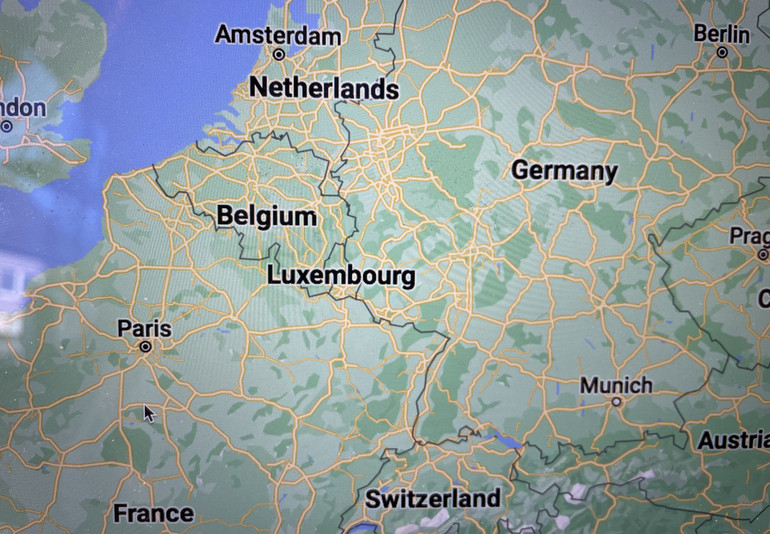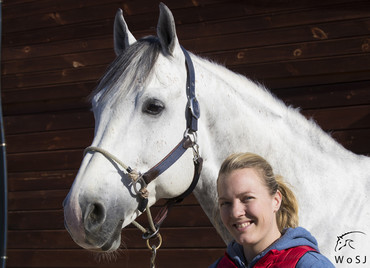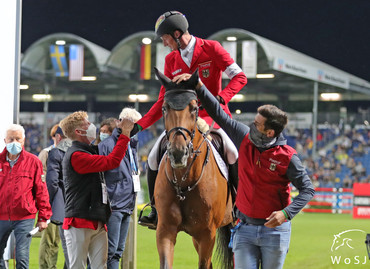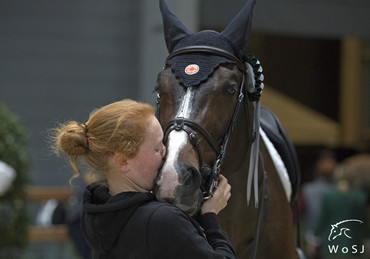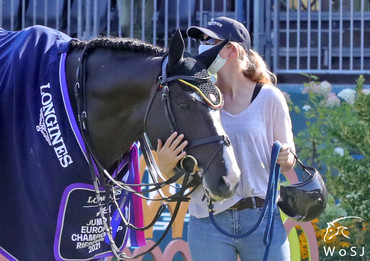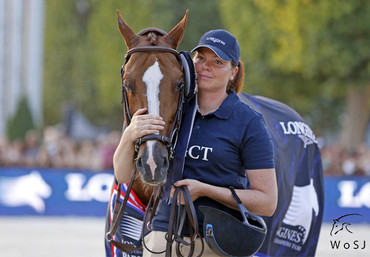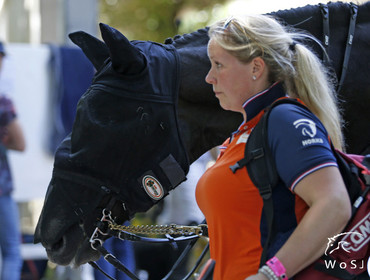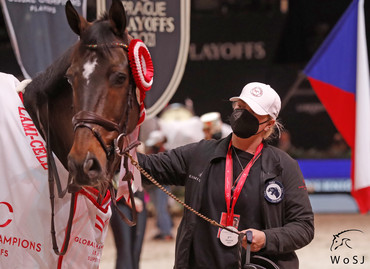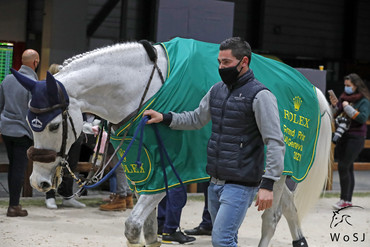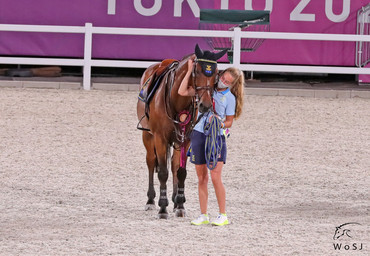With our GoPro-series being such a big hit, WoSJ asked some of the sport’s top grooms to continue to share their knowledge. In this part of the series, we get all their tips and tricks on how to prepare for a long travel with horses.
Malin Henlöv – stable manager for Abdel Said
“When planning for a long trip, I start with checking how far it is and how many times I need to stop. When I worked in Sweden, we had many long journeys with stops on the way and after a while I had some stables where I often stayed over. I think that was really good for the horses, since they knew the places and became more relaxed and calmer. It is important to plan when to drive so you can avoid the traffic, which is hard for both horses and humans. It is often easier to drive through the night, but since I personally find it hard to drive at night I tried to plan to drive through the day and still to avoid the worst traffic.
My advice is to plan and get to know how to best place the horses on the truck – does the horse prefer to have more space, does it want support from the wall, does the horse like a friend next to it or does he/she prefer more personal space? If the horse is calm and relaxed on the truck, the travel hardly takes any energy from the horse, but if he/she travels badly, is in a fight with the neighbour or is kicking, the horse can be tired when arriving. Horses are seldom messy on the truck for no reason, so it is all about finding the best way for it to travel – which can be quite a challenge some times.
When the one driving is taking a break, I like to give the horses some hay and offer them water. If you put some handfuls of mash in the water, most horses will drink. If you have a horse that drinks badly during the travel, it is good to make sure that the horse has drunk properly before and that he/she is drinking well at the stop-overs. When I get to the overnight stabling, I usually give them water and feed when arriving and then I let them rest for a couple of hours. After that I will take them out for some easy work – a hand walk, walker or some easy lunging depending on what works best for the horse and for the place you have stopped at.”
Sean Lynch – groom for Daniel Deusser
“Long trips can be so different depending on where you travel to. But lets go with a drive from Brussels to Madrid. First of all, you need to plan your route and you will see on the map that the distance is around 1600km. I then like to split it up and try to cut the trip into two. When that is done, I look for stabling in that area – in this case it would for example be Bordeaux. I will also take into consideration which bigger towns I will pass and around what times, so I can avoid the traffic. It is not fun when you have horses on the truck and you need to add more hours to an already long trip.
If it’s a stable that I have never used before, I make sure it’s suitable for me. Do they have shavings? Is it easy to access with the truck and trailer? Are the boxes high enough for stallions? Are the stables easy to find in the middle of the night? And very important – how far is it from the highway? There is nothing worse than driving all night to come off the highway and then have to drive 20 minutes through small roads to get to your destination. It makes the trip so much longer and makes it uncomfortable for the horses.
I like to give the horses a minimum of eight hours from the minute they arrive in their overnight boxes and I usually have a layover-routine. I will first tend to give water. When it is warm and a long trip I will add a handful of mash, so I know they will drink well – all horses love mash. I feed hay directly after. When they had their few minutes to roll and look around, I take the bandages off and roll them ready.
Now around 30 minutes have passed (I’m a little slower at doing things after driving far), and I will give them food. Then time to plug in the truck to electricity, clean the back and add fresh shavings. When the food is finished I wash out the buckets and prepare the food for the next meal. Then I take a shower and organise myself. Before going to bed I check the horses one last time to make sure no one has shipping fever and that everyone is healthy. I will check how far I have left to drive, before falling a sleep.
I tend to drive through the night, since the roads are much clearer and it’s a smoother trip for the horses. With our Stephex trucks, we have cameras in the front next to our steering wheel so I can keep an eye on the horses at all times.
I will check the horses a few times throughout the trip – if the weather has changed maybe they are too warm or cold. I try not to bother them too much though, since most of my horses sleep on the truck and with driving through the night I try to let them relax as much as they want.”
Kirsty Pascoe – groom for Jerome Guery
“It is important to organise a long trip before leaving the stables. You should know exactly what way you are going, how many kilometres and how long the drive is. If it is too long to drive in one go, you must organise a layover stable for your horses to rest (and you too).
Before a trip, the last meals the horses have is a mash. It is better for them to have a wet meal rather than dry food before they get on the truck and they don't have water at all times. Depending on whether I travel during the day or over night I will stop more often to give them water, or not. I prefer travelling over night, as they will just rest like they would do if they were in the stables. Over the day it is important for them to have some food at normal feeding times. I call it more "soup" than food as I normally give them a lot of water with some mash in it to give it flavour.”
Jacqueline Schröder – groom for Olivier Philippaerts
“7-10 days before the travel, we start feeding the horses Cavalor Resist + Vitamin C supplement. It contains herbs and antioxidants that support the immune system. I always try, and prefer, to drive over night since there is less traffic and the horses remain calmer.
If we travel to new destinations, for example in big cities, my first task is to look at Google maps to see what’ll be the best road to drive with a truck. I’m always checking for low bridges and small streets, so I can avoid them. I normally get in touch with some other grooms, to share information or speak with the stable manager that normally arrives to the show ground a few days ahead of us.
During the trip, I provide my horses with hay on the truck and when we stop at the gas station they will get water with a bit of mash in it which they drink very well. They will also get a carrot or apple as a snack. My preferred time of arrival at the show ground is super early in the morning – before the morning traffic has started.”
Marlen Schannwell – former groom for Bertram Allen
“Organisation is the key. Plan the trip ahead to make it as comfortable as possible for the horses. If the trip is more than 12 hours, make sure to book good stables on the road. During the trip I offer hay and water and with less than five horses on the truck they will travel lose to stretch their necks in big spaces and have water and hay the whole trip.
It is very important to keep the temperature and airflow as good as possible. The horses should not sweat or freeze at any time and need to have fresh air without it blowing in their faces or over their backs. We used kick pads on the back for all horses to prevent scratches or bruises. Depending on the horse, we used stable boots if needed with overreach boots or bandages.
When it comes to flights – if the horse is a good traveller, it wouldn’t mind flying. In total it’s more comfortable for the horses as the containers don’t move after loading so they can enjoy their hay and water in peace, without breaking or turning. Always work with a good team on the airport, so the horses stay calm while loading. For long trips we need to make sure the horses are well hydrated and have a strong immune system by giving fluids and vitamins before and/or after traveling. Only send the best dust free hay with the horse and stuff that is really needed for the flight – like a light sheet and some in-flight meal like carrots and mash.”
Fran Callan – former groom for Jur Vrieling
“Before a long trip, it is essential to know your horse is healthy. Prepare your stops, know your route and always have a back-up plan! Make sure the horses are drinking well, eating good and are comfortable. I try to feed a good few hours before traveling, giving them time to digest and drink after a feed. Do everything you can to give the horses a stress-free travel.
During a long travel I try to keep the horses hydrated and at a same time try to keep it simple. I make sure to have enough blankets depending on the time and season of travel. I prefer them on the colder side to avoid any discomfort and over-heating. I also prefer to feed during normal feeding hours or work around the feeding hours the best I can. If I travel at night, I don’t feed; I just do a regular water check. Having a camera on board really helps.”
Nickki O’Donovan – groom for Darragh Kenny
“Preparing for a long trip can start a week or two beforehand. Before going in the truck, you must organise your layovers, get health papers and calculate your time and hours correctly. I will check my horses’ passports prior to every show to make sure everything is in order.
Depending on the horse, some might need fluids before a big trip or just some vitamins to boost their immune system. I make up small bags of grain for each horse to have at the layovers; this avoids having to open a big bag of grain when you get there – nothing hurts more than a bag of grain spilling on your truck floor.
I like to make sure that all horses have a bigger space than usual on the truck and I like them to each have a hay-net to keep them busy. I will offer all horses water during the trip, depending on the weather you may need to add blankets or take blankets off.”
Sean Vard – groom for Martin Fuchs
“I always try to keep my same relaxed loading procedure with the horses and have all materials/equipment packed in advance so that there’s no last minute panic packing.
Nowadays there’s not many shows where I actually have never been or at least received feedback or tips about. In my truck, I do however always have some basic things packed for those new places that I’m rocking into without a clue in the world how it’s going to look like or function.
Toolkit - maybe you’ve arrived and the boxes provided are from the First World War and need a little tidy up before you place your precious cargo into them.
Rubber mats - there’s always some little metal drain hole or utilities hole in the ground at a ridiculously unpractical place near the entrance to your box. Rubber mats are lifesavers in these situations! Nobody needs a horse on his side because of something so stupid as that.
Bikes or scooter - If you’ve ever been to a show where the truck is parked 3km away and you forgot your phone charger you’ll know exactly what I mean!
Welly boots - Nothing worse than standing in a corner of a field with a hose pipe, sinking through the rubber mats with your fancy running shoes on trying to remain cool and fancy. Welly boots are more fashionably accepted in those situations than your Nikes.”
Alva Svensson – groom for Peder Fredricson
“Ahead of a long journey, we always make sure to plan and have everything ready well in advance so we can focus on getting proper sleep before starting to drive and focus on the horses. Always make sure that you have packed everything well in advance, so you don’t have to be stressed that something is forgotten or not structured. It is important to keep track of all the needed paperwork and to have a clear “roadmap”. We usually start driving from Sweden since it’s where we live which means that there is a lot of travelling.
We always plan a trip that will work well for both the driver and the horses, the traveling will affect how the horses perform during the competition so therefore we do not drive too long distances, but we also don’t want to make too many “unnecessary” stops on the way which would make it take longer to get to the destination. We usually aim for driving about 9h distances, which works good for both driver and horses. But of course, sometimes it gets a little longer and sometimes a little shorter.
When driving, the horses travel lose with hay and water and we always make sure that there is a lot of space for them. We try to make it as similar as to being in their boxes. This works really well for us and our horses, they travel safe and well and are happy when they have food to entertain themselves with.
When on the road we make stops, sometimes several, depending on where we are going. Arriving at the stop-over stable we always check over the boxes, put up water buckets, give hay and mash. When the horses are installed in their boxes, we always make sure that they feel well, have no wounds and are healthy. Then they get to rest for a few hours. While the horses are resting I will clean the truck and make sure it is completely ready to drive again later.
When the truck is ready, I take some time off and rest too. When both the horses and I have had a rest for some time, I usually go out for a walk, lunge or ride them, it depends a bit on what their needs are. Allan must always be ridden because he has some muscle issues so he must release his energy properly. Allan also always goes for a walk immediately after he has been inside the box, peed and eaten his mash, especially considering his muscles and stomach. All horses are individuals and require slightly different approaches and we are very careful that they always get what they need. Some horses need to move more while others need more recovery and rest after a trip. Of course, it also depends on how used they are to travel far. But we are always careful that they are allowed to both rest and move properly before and after they go on the truck.”
No reproduction without written permission, copyright © World of Showjumping.com



